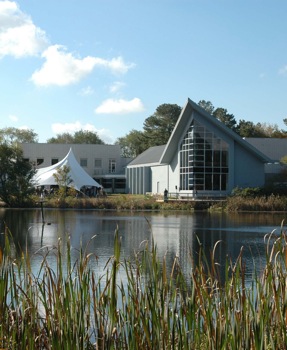
Courtesy Wicomico County CVB
Whether it’s pulling up a load of oysters or scanning the skies for migrating waterfowl, visitors aiming to immerse themselves in the heritage of Maryland’s Eastern Shore can stay as active or as passive as they want.
Many of the quaint coastal towns of the area attract numerous visitors looking to relax and learn more about the state’s far-reaching history, which dates back to the settling of the Colonies.
Museums, beaches and ocean cruises all provide plenty of appealing ways to take in the vistas and culture of the Eastern Shore.
Ocean City
Not only waterfowl flock to the Eastern Shore. Every summer, vacationers seeking warm sun and sandy beaches throng to Ocean City’s popular beach retreat, where they enjoy 10 miles of free white-sand beaches. The three-mile boardwalk leads past shops, restaurants and the Ocean City Life-Saving Station Museum.
“The museum is one of our city’s treasures, and we love to share it with people,” said Donna Abbott, public relations director for the Ocean City Convention and Visitors Bureau. ” In the summer, the museum offers free educational programs to everybody. You can learn all kinds of things from how to tie knots to all about sharks.”
The 40-year history of the United States Life-Saving Service comes to life at the museum with heroic tales of some of the 100,000 rescues performed by the service. Other exhibits highlight all aspects of life by the sea; among the exhibits are two 250-gallon aquariums, the bathing suit collection and the new Boardwalk of Yesterday exhibit about Ocean City’s still evolving boardwalk.
After a day strolling the beach, visitors can sit and listen to the waves at a number of restaurants that serve Maryland’s world-renowned Chesapeake Bay crab cakes and other fresh seafood caught just offshore.
Cambridge
The setting for James Michener’s epic novel Chesapeake, 326-year-old Cambridge retains its historic connection to the fishing industry with active ports filled with fishermen and cruises willing to teach visitors how to haul in a catch of their own.
Large groups can find plenty of room on the Choptank Riverboat Co.’s two 149-passenger reproductions of early 20th-century paddle-wheel riverboats that cruise the Choptank River.
Another historically accurate way to travel the region is aboard the 61-foot-long Nathan of Dorchester, the last skipjack to be built and one of the few skipjacks to offer cruises and authentic oyster-dredging demonstrations. The wooden sailboat teaches about the region’s nautical heritage by allowing passengers to help raise the ship’s sails or man the ship’s helm.
“Each trip on the skipjack is really unique,” said Cyndy Carrington Miller, first mate and crew representative of the Nathan of Dorchester. “You can go out on the boat one time and have one experience, and go out the next day and have a completely different experience, depending on the wind, weather and the crew. It’s a fun organization, because the crew is very dedicated to the boat and its heritage.”
Salisbury
The 12,000-square-foot Ward Museum of Wildfowl Art in Salisbury preserves a piece of the Eastern Shore’s wildfowl heritage as art mixes with nature and tradition in displays of local, national and international wildfowl decoys.
Some exhibits that showcase both antique decoys and contemporary wildfowl sculptures are placed inside reconstructed marsh environments with hunting paraphernalia, simulated morning mist and recorded duck calls.
The museum sits beside a wetlands pond and alongside a trail that connects it to the Salisbury Marina, the Salisbury Zoo and downtown.
“The setting of the museum is beautiful,” said Licia Gliptis, director of marketing and public relations for Wicomico County Convention and Visitors Bureau. “It is next to a pond where you can often see geese and ducks when you walk the nature trail.”
Interpretive trails lead guests around the Schumaker Pond to try and spot some of the geese, herons and other waterfowl from observation blinds or by looking through the observation scope.
The largest city in Maryland’s Eastern Shore also serves as a regional hub for transportation, shopping and lodging.
St. Michaels
At a re-created crabber’s shanty called Waterman’s Wharf, visitors can “tongue for oysters,” watch crabs shed or check an eel pot to get an idea of a fisher’s life on the Chesapeake Bay.
Part of the Chesapeake Bay Maritime Museum in St. Michaels, the wharf allows hands-on interaction with seafood harvesting activities. Visitors can learn more about the industry in the nine exhibit buildings and 18 acres of waterfront campus.
The waterside museum follows the Chesapeake Bay’s seafaring history from Native American culture to the first English settlers. Outside, visitors can climb the 1879 Hooper Strait Lighthouse, which once helped navigate ships through the risky waters of the Hooper Strait.
The museum also boasts the largest collection of Chesapeake Bay boats in the world, including the last sailing log-bottom bugeye and a National Historic Landmark, the Edna E. Lockwood.
Picturesque St. Michaels proudly preserves its bay heritage with historic churches and manicured Colonial, Federal and Victorian homes. In downtown, the historic St. Mary’s Square, originally planned in 1778, still retains a touch of its past with a cannon used to defend St. Michaels against the British in 1813.









